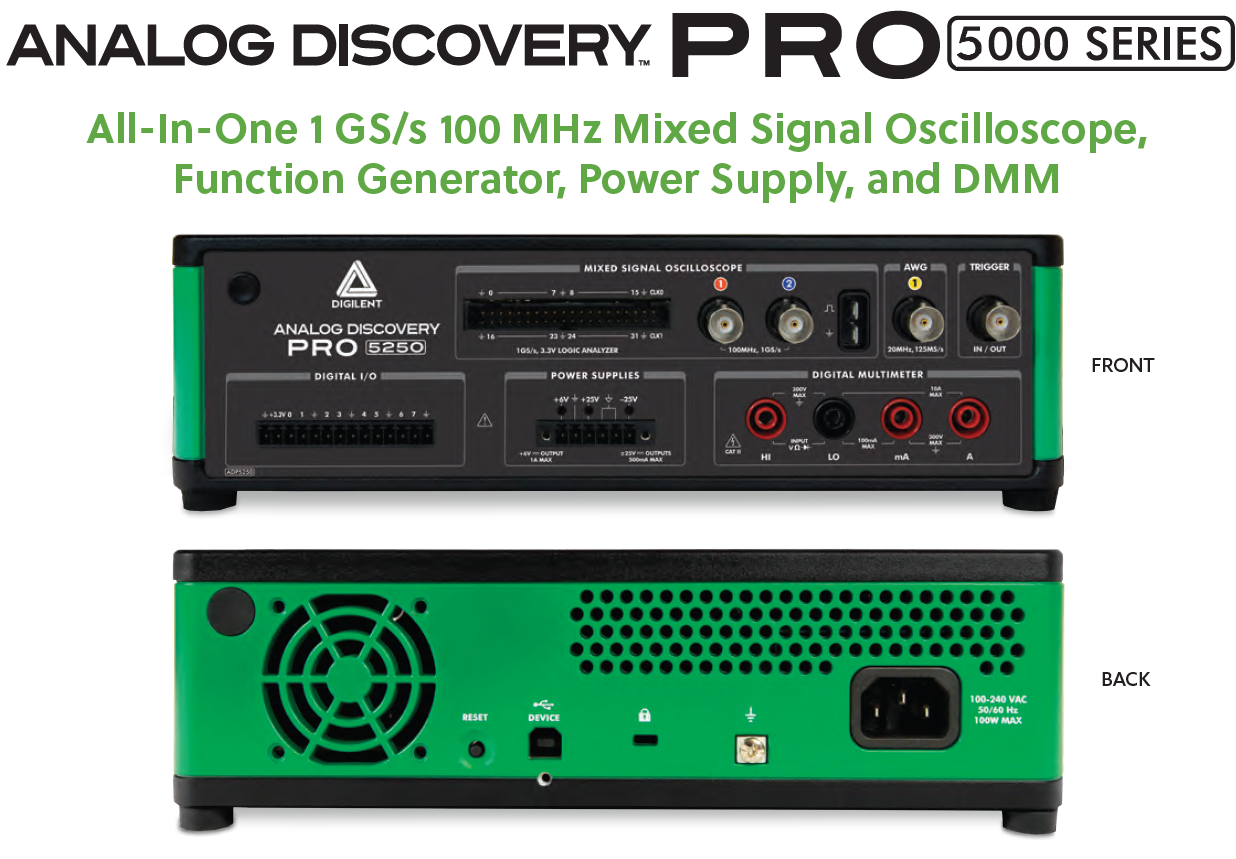USB Oscilloscopes
What is a USB Oscilloscope?
As the name implies, USB oscilloscopes connect to a computer via a USB port, leveraging the computer's processing power, display, and storage capabilities - they also tend to be less expensive than traditional oscilloscopes because of the required connection. Since they utilize a computer, data can be easily saved, shared, and analyzed, facilitating documentation and collaboration. USB oscilloscopes are often more compact and classified as portable oscilloscopes, making them easier to carry and use in various locations.
Digilent’s USB oscilloscopes are travel-ready, offering quick setup and easy deployment in labs, classrooms, or remote environments—ideal for engineers who need portable oscilloscopes that don’t tie them to a bench.
Also known as PC oscilloscopes, these instruments turn your laptop or desktop into a full-featured test bench.
Why Choose Digilent USB Oscilloscopes?
Engineers all over the world use Digilent Test and Measurement devices to decrease their design cycle time and increase their impact by always having an oscilloscope, logic analyzer, waveform generator and more within reach. As a leading provider of PC oscilloscopes, Digilent gives engineers the flexibility to work anywhere—whether that’s a lab, library, or home office—without sacrificing performance.
Our line of Test and Measurement products enables engineers to continue their designs in the library, home office, or even a coffee shop without having to reserve a lab that has all the necessary equipment.
All of our Test and Measurement devices are compatible with the multi-instrument software application, WaveForms. It seamlessly connects our Analog Discovery products and the Digital Discovery with full Windows, macOS, and Linux support.
Designed with a clean, easy-to-use graphical interface for each instrument, WaveForms makes it easy to acquire, visualize, store, analyze, produce and reuse analog and digital signals. And as an added perk, it’s FREE for all to download and use.

Key Features of USB Oscilloscopes
There isn’t a more flexible scope solution or cost-effective value in the industry. With up to 13 functions and a range of specifications between them, our WaveForms-powered products like the Analog Discovery 3, Analog Discovery Pro 3000 Series, and the Analog Discovery Studio are perfectly perfectly capable of acting as an entire stack of lab instruments.
- Oscilloscope
- Arbitrary Waveform Generator
- Power Supplies
- Voltmeter
- Data Logger
- Logic Analyzer
- Digital Pattern Generator
- Virtual I/O
- Spectrum Analyzer
- Network Analyzer
- Impedance Analyzer
- Protocol Analyzer
- Script Editor
Types of USB Oscilloscopes
USB oscilloscopes come in various types, differentiated by their features, performance, and intended applications.
- Basic USB Oscilloscopes:
- Entry-Level: Designed for hobbyists and students, these oscilloscopes offer basic functionality with lower bandwidth and fewer channels.
- Portable: Compact and easy to carry, often used for simple diagnostic tasks and education.
- High-Performance USB Oscilloscopes:
- Professional Grade: High bandwidth, multiple channels, and advanced features for professional engineers and technicians.
- High-Speed: Designed for applications requiring high sampling rates and bandwidth.
- Mixed-Signal USB Oscilloscopes (MSO):
- Combine analog and digital channels, allowing for the analysis of both analog signals and digital data.
- Useful for debugging mixed-signal embedded systems.
- Handheld USB Oscilloscopes:
- Portable and often battery-powered, these are designed for fieldwork and on-site measurements.
- May include built-in displays for standalone use.
High-Performance Measurements
High-performance measurements are crucial for USB oscilloscopes, especially in professional and advanced applications, for several reasons:
Accurate Signal Representation:
- High Bandwidth: Ensures that the oscilloscope can accurately capture and display high-frequency signals without distortion. This is essential for analyzing fast digital signals and high-speed analog waveforms.
- High Sampling Rate: Provides more data points per second, leading to more detailed and precise waveform representation. This is critical for accurately capturing transient events and rapid signal changes.
Detailed Signal Analysis:
- Resolution: Higher resolution allows for finer details in the signal to be observed, which is important for tasks such as noise analysis, signal integrity checks, and detailed waveform analysis.
- Advanced Triggering: High-performance oscilloscopes offer sophisticated triggering options that enable the capture of specific signal events, facilitating detailed analysis of complex signals.
Debugging and Troubleshooting:
- Signal Integrity: High-performance measurements help in identifying and diagnosing issues such as signal degradation, interference, and timing problems. This is essential for debugging and troubleshooting complex electronic systems.
- Mixed-Signal Analysis: For systems that involve both analog and digital components, high-performance mixed-signal capabilities allow for simultaneous analysis of both types of signals, aiding in comprehensive system debugging.
Testing and Validation:
- Compliance Testing: High-performance USB oscilloscopes are often required to meet industry standards for testing and validation, ensuring that devices comply with relevant specifications and regulations.
- Precision Measurements: For applications in fields such as aerospace, telecommunications, and medical devices, precision measurements are critical for ensuring the reliability and performance of the systems being tested.
Data Analysis and Reporting:
- Advanced Features: High-performance USB oscilloscopes come with advanced analysis features such as FFT, protocol decoding, and automated measurements, which are invaluable for detailed data analysis and reporting.
- Reliability: High-quality measurements ensure the reliability of the data, which is crucial for making informed decisions based on the analysis.
Choosing the Right USB Oscilloscope
Digilent Essential Instruments
All Digilent test and measurement devices are multi-instrument electronics tools designed to bring the benchtop to you. Digilent's portable USB scopes, logic analyzers and signal generators allow you to measure, visualize, generate, record, and control mixed-signal circuits of all kinds. Combined with our free WaveForms software, detailed documentation, and a dedicated support community, our test and measurement hardware will turn your computer into a multi-instrument circuit analysis tool, all without the physical constraints of a lab.
Analog Discovery Pro Line
With the two new entries into the ADP 5000 Series of devices, Digilent now has six different products with the ‘Analog Discovery Pro’ moniker across three families — double the number of devices in the Analog Discovery Essentials family, which all have their own unique capabilities.
- 2000 Series — USB 3.0 speeds
- 3000 Series — Embedded Linux capability
- 5000 Series — Fastest and highest bandwidth oscilloscope
Additional Resources
For more information about our offering of USB oscilloscopes, please visit our Resource Center where you will find reference manuals, datasheets, getting started guides and more! Or browse our Forum and feel free to post any questions you might have regarding our mixed signal oscilloscope capabilities and our engineers would be more than happy to assist.
FAQ
- What type of software is used with Digilent USB oscilloscopes?
- All of our USB oscilloscope devices work seamlessly with the multi-instrument software application, WaveForms.
- Has the bandwidth of the Analog Discovery 3 been increased when compared to the Analog Discovery 2?
- The sample rate has been increased from 100 to 125 Ms/s, however, the bandwidth has not been increased; it is still 9 MHz for the Oscilloscope and AWG using the MTE cables and 30 MHz for the Scope and 12 MHz for the AWG when using the BNC adapter. The specifications of the Analog Discovery 3 with and without the BNC Adapter are covered in the AD3 specifications, here: Analog Discovery 3 Specifications
- Can the plug in devices, like Audio Adapter+ and Impedance Analyzer module be concatenated?
- Generally, no. The Audio Adapter+, for example, does not forward its Scope channel pins out to the 2×15 header, to avoid drive conflicts or shorts. That said, unused pins are generally available on an additional 2×15 header on the adapter so that you can still simultaneously use digital I/Os or other pins. All existing adapters created for the Analog Discovery 2 are all still supported by the Analog Discovery 3.
- What is the difference between the Analog Discovery Pro 5250, 5470, and 5490?
- The ADP 5250, 5470, and 5490 primarily differ in their analog input specifications. All models include a digital multimeter, power supplies, a waveform generator, and a logic analyzer. The 5250 has 2 channels at 100 MHz bandwidth at 500 MS/s per channel, the 5470 has 4 channels at 350 MHz bandwidth at 1.5 GS/s per channel, and the 5490 has 4 channels at 500 MHz bandwidth at 2 GS/s per channel.
- Please note: The ADP 5250 (411-001) is retired and no longer for sale in our store. Please consider the ADP5470 as a replacement option.
- Wait a second, isn’t the Analog Discovery Pro 5000 Series the same as the NI Virtual Bench?
- Good eye! The Analog Discovery Pro 5000 Series is indeed based on the NI VirtualBench all-in-one test device. The primary difference is the native integration with Digilent’s WaveForms software providing more flexible configuration, control, and convenience to the device.
- What are the advantages of using a portable oscilloscope in industrial or field applications?
- Portable oscilloscopes are ideal for field engineers and technicians who need a compact, lightweight tool for on-site diagnostics. Their small size, USB power, and PC-based control make them especially useful in automotive, telecom, and aerospace environments where bench space is limited or unavailable.
- How does a USB oscilloscope compare to a benchtop oscilloscope?
- A USB oscilloscope uses your computer for display, storage, and processing—resulting in a more compact and affordable alternative to bulky standalone scopes. While benchtop models may offer higher-end specs, USB scopes like the Analog Discovery Pro series provide impressive bandwidth and sampling rates, sufficient for most professional use cases.
- What is a PC oscilloscope and how is it different from a standalone one?
- A PC oscilloscope (or USB oscilloscope) is a compact measurement device that connects to your computer via USB and uses your PC’s display, storage, and processing power. Unlike traditional benchtop scopes with built-in screens, PC oscilloscopes rely on software for control and visualization, making them lighter, more portable, and often more affordable without sacrificing core functionality.
- What type of software is used with Digilent USB oscilloscopes?
- All of our USB oscilloscopes come with WaveForms, the multi-instrument software application included with all Digilent Test and Measurement devices.








